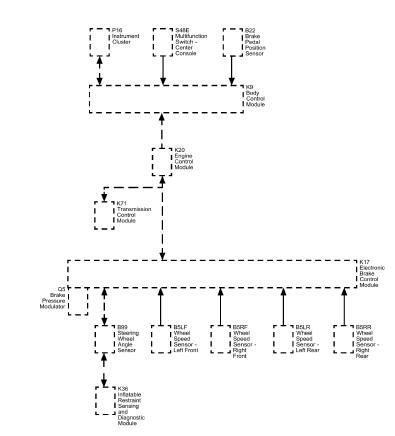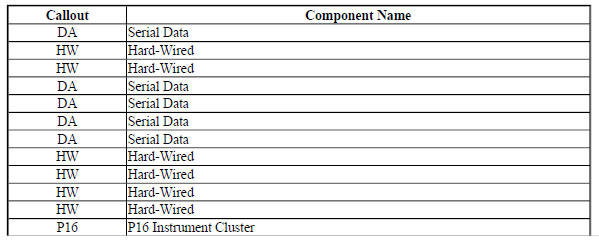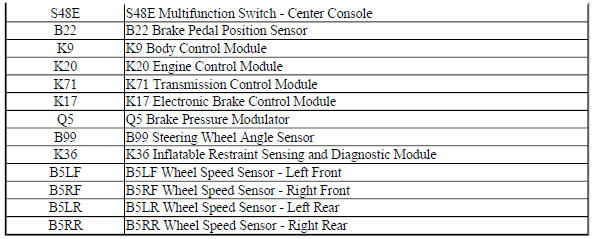Chevrolet Trax: Description and operation
ABS DESCRIPTION AND OPERATION
Antilock Brake System Block Diagram

Fig. 45: Antilock Brake System Block Diagram


This vehicle is equipped with the MGH 60 Mando electronic stability control brake system. The electronic brake control module and the brake pressure modulator are serviced separately. The brake pressure modulator uses a four circuit configuration to control hydraulic pressure to each wheel independently.
Depending on options, the following vehicle performance enhancement systems are provided.
- ABS
- Electronic brake distribution
- Hill Descent Control System
- Hill Start Hold
- Traction Control System
- Vehicle Stability Enhancement System
The following components listed below are involved in the operation of the brake system:
- Electronic brake control module - The electronic brake control module controls the system functions and detects failures. It supplies voltage to the solenoid valves and pump motor.
- Brake pressure modulator-The brake pressure modulator contains the hydraulic valves and pump motor that are controlled electrically by the electronic brake control module. The brake pressure modulator uses a four circuit configuration with a diagonal split. The brake pressure modulator directs fluid from the reservoir of the master cylinder to the left front and right rear wheels and fluid from the other reservoir to the right front and left rear wheels. The diagonal circuits are hydraulically isolated so that a leak or malfunction in one circuit will allow continued braking ability on the other.
The brake pressure modulator contains the following components:
- Pump motor
- Inlet valves (one per wheel)
- Outlet valves (one per wheel)
- Two traction control/stability control supply valves
- Two traction control/stability control isolation valves
- Brake pressure sensor
- Wheel speed sensors - The wheel speed sensors are Active sensors that
receive a 12-volt power supply
voltage from the electronic brake control module and provides an output
signal to the module. As the
wheel spins, the wheel speed sensor sends the electronic brake control
module a DC square wave signal.
The electronic brake control module uses the frequency of the square wave signal to calculate the wheel speed.
- Traction Control Switch - The vehicle stability enhancement system and the engine torque reduction function of the traction control system are manually disabled or enabled by pressing the traction control switch.
- Steering Wheel Angle Sensor - The electronic brake control module receives serial data message inputs from the steering wheel angle sensor. The steering wheel angle signal is used to calculate the driver intended driving direction.
- Multi-axis acceleration sensor - The yaw rate, lateral acceleration and longitudinal acceleration sensors are combined into one multi-axis acceleration sensor, internal to the inflatable restraint sensing and diagnostic module. The electronic brake control module receives serial data message inputs from the yaw rate, lateral acceleration and longitudinal acceleration sensor and activates stability control and hill hold start assist function depending on multi-axis acceleration sensor input.
Initialization Sequence
The electronic brake control module performs one initialization test each ignition cycle. The initialization of the electronic brake control module occurs when both the following conditions occur:
- The vehicle speed is greater than 20 km/h (12 MPH).
- The stop lamp switch is not applied.
The initialization sequence cycles each solenoid valve and the pump motor, as well as the necessary relays, for approximately 1.5 seconds to check component operation. The electronic brake control module sets a DTC if any error is detected. The initialization sequence may be heard and felt while it is taking place, and is considered part of normal system operation.
The electronic brake control module defines a drive cycle as the completion of the initialization sequence.
Antilock Brake System
When wheel slip is detected during a brake application, the ABS enters antilock mode. During antilock braking, hydraulic pressure in the individual wheel circuits is controlled to prevent any wheel from slipping. A separate hydraulic line and specific solenoid valves are provided for each wheel. The ABS can decrease, hold, or increase hydraulic pressure to each wheel brake. The ABS cannot, however, increase hydraulic pressure above the amount which is transmitted by the master cylinder during braking.
During antilock braking, a series of rapid pulsations is felt in the brake pedal. These pulsations are caused by the rapid changes in position of the individual solenoid valves as the electronic brake control module responds to wheel speed sensor inputs and attempts to prevent wheel slip. These pedal pulsations are present only during antilock braking and stop when normal braking is resumed or when the vehicle comes to a stop. A ticking or popping noise may also be heard as the solenoid valves cycle rapidly. During antilock braking on dry pavement, intermittent chirping noises may be heard as the tires approach slipping. These noises and pedal pulsations are considered normal during antilock operation.
Vehicles equipped with ABS may be stopped by applying normal force to the brake pedal. Brake pedal operation during normal braking is no different than that of previous non-ABS systems. Maintaining a constant force on the brake pedal provides the shortest stopping distance while maintaining vehicle stability.
Pressure Hold
The electronic brake control module closes the inlet valve and keeps the outlet valve closed in order to isolate the system when wheel slip occurs. This holds the pressure steady on the brake so that the hydraulic pressure does not increase or decrease.
Pressure Decrease
The electronic brake control module decreases the pressure to individual wheels during a deceleration when wheel slip occurs. The inlet valve is closed and the outlet valve is opened. The excess fluid is stored in the accumulator until the return pump can return the fluid to the master cylinder.
Pressure Increase
The electronic brake control module increases the pressure to individual wheels during a deceleration in order to reduce the speed of the wheel. The inlet valve is opened and the outlet valve is closed. The increased pressure is delivered from the master cylinder.
Electronic Brake Distribution
The electronic brake distribution is a control system that replaces the hydraulic proportioning function of the mechanical proportioning valve in the base brake system. The electronic brake distribution control system is part of the operation software in the electronic brake control module. The electronic brake distribution uses active control with existing ABS in order to regulate the vehicle's rear brake pressure.
The red brake warning indicator is illuminated when the electronic brake distribution function is disabled.
Hill Descent Control System
The hill descent control system allows a smooth and controlled hill descent in rough terrain without the driver needing to touch the brake pedal. The vehicle will automatically decelerate to a low speed and remain at that speed while activated. Some noise or vibration from the brake system may be apparent when the system is active. The descent control system may be activated, if equipped, by pressing the button on the console. To activate, press the button when traveling at speeds less that 50 km/h (30 MPH). To deactivate, press the button on the console, the brake pedal, or the accelerator. Descent control enables the vehicle to descend using the ABS to control each wheel's speed. If the vehicle accelerates without driver input, the system automatically applies the brakes to slow the vehicle down to the desired speed
Hill Start Hold
Some vehicles are equipped with the Hill Hold Start technology feature. When stopped on a hill, the Hill Start Hold feature prevents the vehicle from rolling before driving off, whether facing uphill or downhill by holding the brake pressure during the transition between when the driver releases the brake pedal and starts to accelerate. The Electronic Brake Control Module calculates the brake pressure, which is needed to hold the vehicle on an incline or grade greater than 5% and locks that pressure for up to two seconds by commanding the appropriate solenoid valves ON and OFF when the brake pedal is released. The stop lamps will stay illuminated during the Hill-Hold operation even though the brake pedal is released, this is considered normal operation.
The Hill Start Hold feature is determined by the electronic brake control module using the following inputs:
- Accelerator pedal position sensor
- Brake pedal position sensor
- Multi-axis acceleration sensor
Traction Control System
When drive wheel slip is noted while the brake is not applied, the electronic brake control module will enter traction control mode.
First, the electronic brake control module requests the engine control module to reduce the amount of torque to the drive wheels via the serial data. The engine control module reduces torque to the drive wheels by retarding spark timing and turning off fuel injectors. The engine control module reports the amount of torque delivered to the drive wheels via the serial data circuit.
- Pressure hold
- Pressure increase
- Pressure decrease
Vehicle Stability Enhancement System
The vehicle stability enhancement system adds an additional level of vehicle control to the electronic brake control module.
Yaw rate is the rate of rotation about the vehicles vertical axis. The vehicle stability enhancement system is activated when the electronic brake control module determines that the desired yaw rate does not match the actual yaw rate as measured by the yaw rate sensor.
The desired yaw rate is calculated from the following parameters:
- The position of the steering wheel
- The speed of the vehicle
- The lateral acceleration of the vehicle
The difference between the desired yaw rate and the actual yaw rate is the yaw rate error, which is a measurement of over steer or under steer. If the yaw error becomes too large, the electronic brake control module attempts to correct the vehicles yaw rate motion by applying differential braking to the appropriate wheel. The amount of differential braking applied to the left or right front wheel is based on both the yaw rate error and side slip rate error.
The vehicle stability enhancement system activations generally occur during aggressive driving, in turns or on bumpy roads without much use of the accelerator pedal. When braking during vehicle stability enhancement system activation, the pedal pulsations feel different than the ABS pedal pulsations. The brake pedal pulsates at a higher frequency during vehicle stability enhancement system activation.
Driver Information Indicator
ABS Warning Indicator
The instrument cluster turns the ABS warning indicator ON when the following occurs:
- The instrument cluster performs the bulb check.
- The electronic brake control module detects a malfunction which disables the ABS and sends a serial data message to the instrument cluster requesting illumination.
Brake Warning Indicator
The instrument cluster turns five brake warning indicator ON when the following occurs:
- The instrument cluster performs the bulb check.
- The electronic brake control module detects some faults, such as more than two wheel speed sensors are defective or the failure relating to the basic brake system occurs and sends a serial data message to the instrument cluster requesting illumination.
- The park brake is engaged or the brake fluid level is low.
Traction Control System OFF Indicator
The instrument cluster turns the Traction Control Off indicator ON when the following occurs:
- The instrument cluster performs the bulb check.
- The driver manually disables the traction control by pressing the traction control switch one time and releasing it. The body control module and electronic brake control module sends a serial data message to the instrument cluster requesting illumination.
- The electronic brake control module detects a malfunction which disables the traction control and sends a serial data message to the instrument cluster requesting illumination of the Traction Control Off indicator.
Stability Control System OFF Indicator
The instrument cluster turns the Stability Control Off indicator ON when the following occurs:
- The instrument cluster performs the bulb check.
- The driver manually disables the stability control by pressing an holding the traction control switch down for five seconds. The electronic brake control module sends a serial data message to the instrument cluster requesting illumination.
- The electronic brake control module detects a malfunction which disables the stability control system it sends a serial data message to the instrument cluster requesting illumination of the Stability Control Off indicator.
Traction/Stability Control System Warning Indicator
The instrument cluster turns the traction/stability control system warning indicator ON when the following occurs:
- The instrument cluster performs the bulb check.
- The electronic brake control module detects a malfunction which disables the traction control or stability control and sends a serial data message to the instrument cluster requesting illumination.

